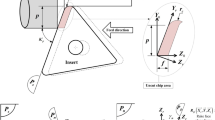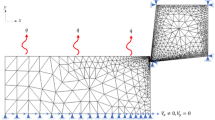Abstract
A predictive thermal analytical model based on the improved Oxley’s theory and the image heat source method for orthogonal cutting was proposed to obtain the exact temperature distributions in the chip, tool, and workpiece during cryogenic machining. The influences of some important factors, including the shear deformation at primary zone, the friction at tool-chip interface, and the heat losses at both rake and flank faces of the tool caused by liquid nitrogen jetting, were all considered in the thermal model. The heat loss of rake face was divided into contact and non-contact zones to calculate the cooling effects at different positions. Heat partition ratios were utilized to modify the non-uniform distribution at tool-chip interface for all the heat sources and losses, respectively. The cutting parameters were optimized to avoid the low precision and efficiency of iterative algorithm. Cryogenic turning experiments were performed to verify the analytical model of temperature distribution. The results showed that the average errors of the predicted temperatures were lower than 3.30%.












Similar content being viewed by others
References
Huang Y, Ji J, Lee KM (2018) An improved material constitutive model considering temperature-dependent dynamic recrystallization for numerical analysis of Ti-6Al-4V alloy machining. Int J Adv Manuf Technol 97(9–12):3655–3670
Kaynak Y, Lu T, Jawahir IS (2014) Cryogenic machining-induced surface integrity: a review and comparison with dry, MQL, and flood-cooled machining. Mach Sci Technol 18(2):149–198
Jawahir IS, Attia H, Biermann D, Duflou J, Klocke F, Meyer D, Newman ST, Pusavec F, Putz M, Rech J, Schulze V, Umbrello D (2016) Cryogenic manufacturing processes. CIRP Ann 65(2):713–736
Yildiz Y, Nalbant M (2008) A review of cryogenic cooling in machining processes. Int J Mach Tools Manuf 48(9):947–964
Hong SY, Ding Y (2001) Cooling approaches and cutting temperatures in cryogenic machining of Ti-6Al-4V. Int J Mach Tools Manuf 41(10):1417–1437
Gok K (2015) Development of three-dimensional finite element model to calculate the turning processing parameters in turning operations. Measurement 75:57–68
Komanduri R, Hou ZB (2000) Thermal modeling of the metal cutting process: part I—temperature rise distribution due to shear plane heat source. Int J Mech Sci 42(9):1715–1752
Komanduri R, Hou ZB (2001) Thermal modeling of the metal cutting process—part II: temperature rise distribution due to frictional heat source at the tool–chip interface. Int J Mech Sci 43(1):57–88
Komanduri R, Hou ZB (2001) Thermal modeling of the metal cutting process—part III: temperature rise distribution due to the combined effects of shear plane heat source and the tool–chip interface frictional heat source. Int J Mech Sci 43(1):89–107
Huang Y, Liang SY (2005) Cutting temperature modeling based on non-uniform heat intensity and partition ratio. Mach Sci Technol 9(3):301–323
Huang Y, Liang SY (2003) Modelling of the cutting temperature distribution under the tool flank wear effect. Proc Inst Mech Eng C J Mech Eng Sci 217(11):1195–1208
Karpat Y, Özel T (2006) Predictive analytical and thermal modeling of orthogonal cutting process—part I: predictions of tool forces, stresses, and temperature distributions. J Manuf Sci Eng 128(2):435–444
Karpat Y, Özel T (2006) Predictive analytical and thermal modeling of orthogonal cutting process—part II: effect of tool flank wear on tool forces, stresses, and temperature distributions. J Manuf Sci Eng 128(2):445–453
Li KM, Liang SY (2006) Modeling of cutting temperature in near dry machining. J Manuf Sci Eng 128(2):416–424
Zhou F (2014) A new analytical tool-chip friction model in dry cutting. Int J Adv Manuf Technol 70(1–4):309–319
Huang K, Yang W (2016) Analytical model of temperature field in workpiece machined surface layer in orthogonal cutting. J Mater Process Technol 229:375–389
Mulyana T, Rahim EA, Yahaya SNM (2017) The influence of cryogenic supercritical carbon dioxide cooling on tool wear during machining high thermal conductivity steel. J Clean Prod 164:950–962
Danish M, Ginta TL, Habib K, Carou D, Rani AMA, Saha BB (2017) Thermal analysis during turning of AZ31 magnesium alloy under dry and cryogenic conditions. Int J Adv Manuf Technol 91(5–8):2855–2868
Kim DM, Banerjee N, Park HW (2018) Predictive modeling for the cryogenic cooling condition of the hard turning process. Int J Adv Manuf Technol 99(9–12):2877–2891
Shi B, Elsayed A, Damir A, Attia H, M'Saoubi R (2019) A hybrid modeling approach for characterization and simulation of cryogenic machining of Ti–6Al–4V alloy. J Manuf Sci Eng 141(2):021021
Lequien P, Poulachon G, Outeiro JC, Rech J (2018) Hybrid experimental/modelling methodology for identifying the convective heat transfer coefficient in cryogenic assisted machining. Appl Therm Eng 128:500–507
Gok A (2017) 2D numeric simulation of serrated Chip formation in orthogonal cutting of AISI316h stainless steel. Mater Technol 51(6):953–956
Gok K, Sari H, Gok A, Neseli S, Turkes E, Yaldiz S (2017) Three-dimensional finite element modeling of effect on the cutting forces of rake angle and approach angle in milling. Proc Inst Mech Eng E J Pro 231(2):83–88
Gok A (2015) A new approach to minimization of the surface roughness and cutting force via fuzzy TOPSIS, multi-objective grey design and RSA. Measurement 70:100–109
Oxley PLB (1989) The mechanics of machining: an analytical approach to assessing machinability. Ellis Horwood Publisher, New York
Adibi-Sedeh AH, Madhavan V, Bahr B (2003) Extension of Oxley’s analysis of machining to use different material models. J Manuf Sci Eng 125(4):656–666
Huang Y, Liang SY (2003) Cutting forces modeling considering the effect of tool thermal property—application to CBN hard turning. Int J Mach Tools Manuf 43(3):307–315
Lalwani DI, Mehta NK, Jain PK, Li B, Fang N (2009) Extension of Oxley's predictive machining theory for Johnson and Cook flow stress model. J Mater Process Technol 209(12–13):5305–5312
Xiong LS, Wang J, Gan YY, Li B, Fang N (2015) Improvement of algorithm and prediction precision of an extended Oxley’s theoretical model. Int J Adv Manuf Technol 77(1–4):1–13
Jaeger JC (1942) Moving sources of heat and the temperature of sliding contacts. Proc R Soc NSW 76:203–224
Li L, He N (2006) A FEA study on mechanisms of saw-tooth chip deformation in high speed cutting of Ti6–Al–4V alloy. In: proceedings of the fifth international conference on high Sped machining, Metz, France. pp 759–767
Boothroyd G (1963) Temperatures in orthogonal metal cutting. Proc Inst Mech Eng 177(1):789–810
Acknowledgments
Furthermore, the authors thank the anonymous referees and editor for their valuable comments and suggestions.
Funding
This research was supported in part by the National Natural Science Foundation of China (U1608251, 51775085), LiaoNing Revitalization Talents Program (XLYC1807081), Top and Leading Talents of Dalian (2018RD05, 2018RQ14), Changjiang Scholar Program of the Chinese Ministry of Education (T2017030), and Open Project of State Key Lab of Digital Manufacturing Equipment & Technology (DMETKF2019014).
Author information
Authors and Affiliations
Corresponding author
Additional information
Publisher’s note
Springer Nature remains neutral with regard to jurisdictional claims in published maps and institutional affiliations.
Rights and permissions
About this article
Cite this article
Wang, Y., Liu, J., Liu, K. et al. Modeling of temperature distribution in turning of Ti-6Al-4V with liquid nitrogen cooling. Int J Adv Manuf Technol 107, 451–462 (2020). https://doi.org/10.1007/s00170-020-05093-4
Received:
Accepted:
Published:
Issue Date:
DOI: https://doi.org/10.1007/s00170-020-05093-4




